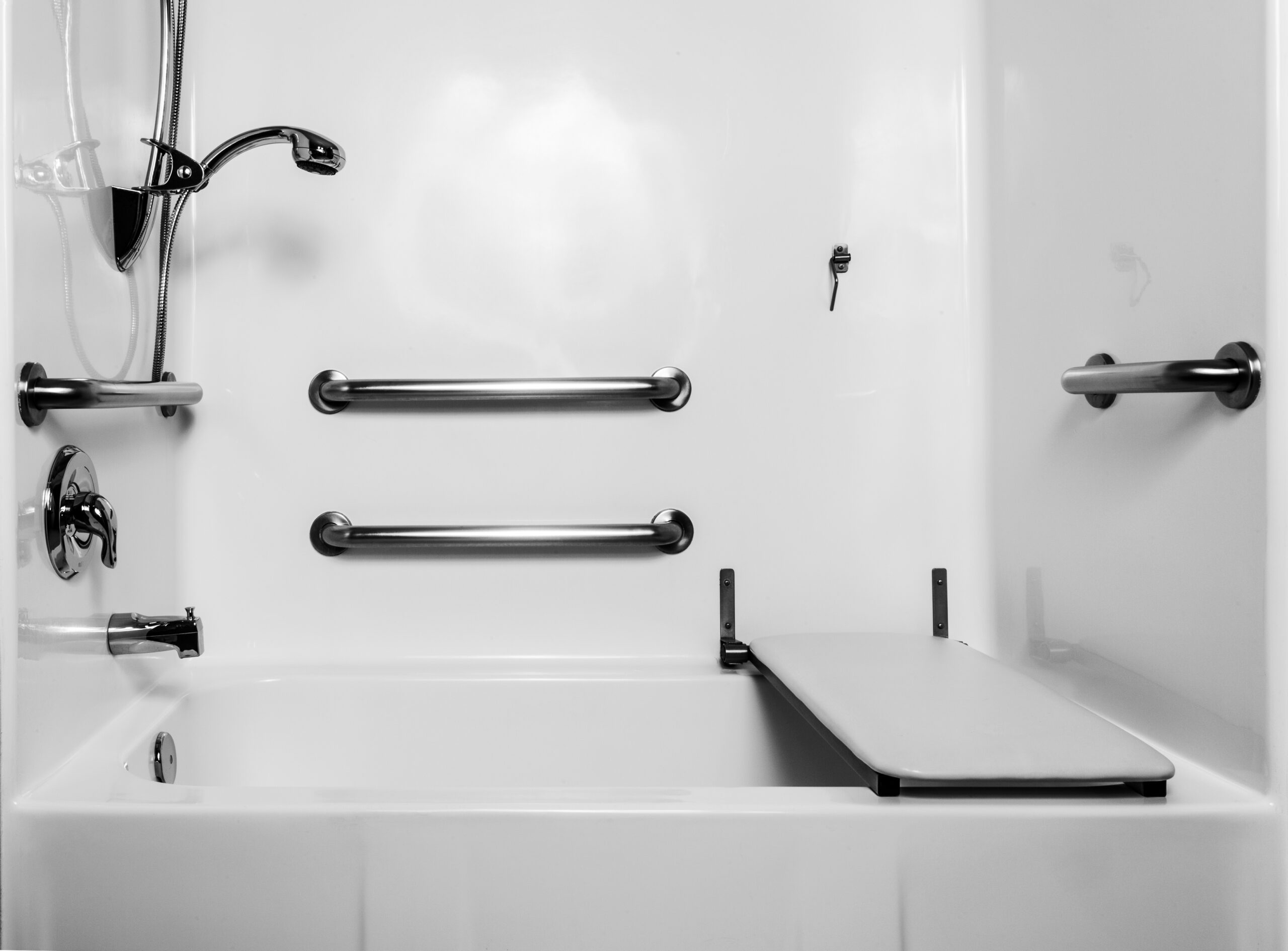Bath Aids for Getting in and Out of the Bath

Whatever your age, washing and bathing is part of everyday life. But as we get older, many of us prefer the comfort of sinking into a warm bath over standing up in the shower.
It can be easy to take getting in and out of the bath safely for granted.
But for older people and people with mobility issues, this action can be a significant source of anxiety.
Bath aids for getting in and out of the bath are one way to address this.
By installing mobility aids for getting in and out of the bath, you can feel more confident that you’ll be able to get in and out of the bathtub safely. It’s a great way to maintain your independence and self-confidence.
So, let’s break down some of the most useful aids for getting in and out of the bath.
Are you affected by mobility issues when bathing?
Fill out the form in seconds and discover our full range of assisted bathing showers and baths.

What are mobility bathing aids?
Bathing aids are a solitary piece, or combination of pieces of equipment, that help a person to get in and out of the bath or shower safely.
Today, there are many different types of bath aids for getting in and out of the bath, as well as bathing solutions for people with mobility issues.
These aids are designed with the user in mind, helping people with reduced mobility to bathe safely and securely.
In addition, they also make it easier for carers and family members who provide assistance with bathing, lowering the risk of injury for them and the person they are helping.
While some bathing aids are simple in design, they can be a life-changing addition to the bathroom of an older person who wants to continue living in their existing home. They play a crucial role in reducing the risk of slips, trips and falls, and they also help to prevent injury to care workers.
From simple grab rails, non-slip mats and bath seats, to bath lifts and walk-in baths, there are many different bath aids for getting in and out of the bath to choose from.
Best Bath Aids for Older People and People with Mobility Issues
If you need bath aids for getting in and out of the bath or you’re looking for aids to help a loved one, let’s take a look at some of the options available to you.
1. Grab rails
Grab rails are a versatile aid. They serve a number of functions in the bathroom and are a common feature in fully-accessible rooms. They help the user to pull themselves to a standing position, or allow them to lower themselves safely into the bath.
You can either choose grab rails that can be securely fixed to the walls, or suction-style rails which allow you to reposition them, take them on holiday or use them in a friend or relative’s home.
Suction rails are portable, discreet, and can be used almost anywhere. Grab rails can also be secured to the side of the bath and used alongside bath steps, enabling easy and safe access in and out of the bath.
2. Bath steps
A bath step is a simple yet effective aid which helps people with mobility issues to get in and out of the bath safely. They are a popular choice for older people who find it difficult to climb over the side of the bath.
However, you need to be careful when using these bath steps, as they can slip and cause an injury. For the safest and most secure approach, then a walk-in bath is for you. These have a built-in door that allows you to step into the bath very easily and with no worry about whether the step may move when you are stepping on it.
3. Bath boards
A bath board sits securely across the width of the bath. It can be used to sit on as you wash, without needing to fully lower yourself into the bath. This piece of equipment is effective for older people who find it difficult to lower themselves in and out of the bath.
4. Bath fillers
Overflow bath fillers make bathing more accessible for people who struggle with strength issues.
A bath filler saves space by removing the need for taps, ensuring an easier experience when it comes to filling the bath with water. The design of a bath filler mixes the hot and cold water together in one stream, while the overflow facility prevents water from flowing over the top of the bath.
Bathing meets modern technology with some of the latest advances in bath fillers for walk-in baths. By using the temperature dial or an app on your mobile phone, you can fill up a walk-in bath with water at exactly the right temperature, eliminating the need to continually adjust.
Once you have the desired temperature, simply press the start button and relax for the perfect soak in the bath.
5. Bath seats
Having a specialised bath seat for older people or people with mobility issues can make an enormous difference to the quality of their bathing routine. Bath seats are designed to help people who have difficulty fully lowering themselves into, or rising from, the depth of the bath.
There are various designs to choose from, but by far the safest and most secure seats in your bath will be included in walk-in baths. You have a wide range of options, with naturally in-built seats that either make you sit up straight, or sit lower and be lifted into and out of the bath.
6. Bath mats and pillows
Bath mats add an extra layer of safety to your bathing routine. They sit on the floor of the bath and are designed to prevent slipping when climbing in and out. Bath mats use suction cups on the underside of the mat. These cups stick to the floor of the bath and help to reduce the risk of slips and falls.
Bath pillows provide additional comfort when you’re relaxing in the bath. Most bath pillows are inflatable, and they are held in place with suction cups. They fit behind the neck, providing support to people who find it difficult to sit upright.
7. Bath lifts
A bath lift helps to make the process of getting in and out of the bath easier, particularly for people with severe mobility issues or disabilities. Baths with a power seat lift ready-built in allow for the easiest entry and exit out of the bath.
An alternative option could be to use an inflatable bath lift. These devices typically consist of an inflatable cushion or seat that is placed inside the tub. Like the permanent ones, inflatable bath lifts assist older people by raising and lowering them into the bath water.
However, these are nowhere near as reliable as permanent bath lifts, which are very sturdy and built to last.
8. Bath hoists
A bath hoist stands outside the bath, but it is connected to a chair that lowers into the bath. A bath hoist helps caregivers to bathe service users with minimal risk of injury.
Electric bath hoists are fitted with a motor and remote control to make the process as easy as possible. They can be bulky and are often used in specialist settings rather than in the home.
9. Walk-in bath
Walk-in baths offer older people and people with mobility issues a safe and easy way to bathe. A low-level door at the side allows for easy access to the tub, while the non-slip surface, bath seats and grab rails make walk-in baths a safe and comfortable place to bathe and relax in.
How to Choose the Right Aids to Get In and Out of the Bath
There are a few things to consider when choosing mobility aids for getting in and out of the bath.
Firstly, you’ll need to think about the style and type of bath that’s already in place. Is it possible to add mobility aids to the existing bathroom set up, or will you need to consider installing a whole new bathtub?
Next, you’ll need to look at the size of the bathroom. If the bathroom is small, you could look at installing a compact walk-in bath. If you have more space, you might consider a larger model.
You’ll also need to consider the type of assistance that’s required, and whether this is likely to change in the future.
Finally, it’s important to consider your budget. Bath steps, grab rails, mats, and pillows are relatively inexpensive options that can make a real difference to older people.
However, if your mobility needs are more complex, you might need to invest in more expensive solutions such as walk-in baths, bath lifts and hoists.
What are the Benefits of Bath Aids?
- Safety
Safety is paramount when it comes to helping older people and people with mobility issues to bathe.
This applies to both the person and the family member or carer involved in helping them with their personal care and bathing.
The fear of slipping on a wet surface or struggling to stand unaided can weigh heavy on a person’s mind.
These worries could eventually lead to a reluctance to bathe at all. Using bathing aids can also drastically reduce the risk of injury to carers.
- Independence
While carers or family members may be willing and able to assist, installing bath aids could help older people and people with mobility issues to maintain a sense of independence when bathing.
- Comfort
Installing bathing aids will help to make the bathing experience more comfortable and enjoyable.
What Professional Advice is Available When Choosing Mobility Aids for Getting In and Out of the Bath?
Professional help is available to help you find the most appropriate bath aids for getting in and out of the bath. An Occupational Therapist (OT) is one type of specialist who works with older people and people with mobility issues to improve their quality of life.
An OT can help people who:
- Have a physical disability
- Are recovering from an illness or operation
- Have a learning disability
- Have a mental health condition
- Are getting older
Access to an OT can be arranged via GP referral, or by contacting the local authority and asking for occupational therapy assistance. OT’s can also provide private services, however, these must be funded by the service user.
An initial OT assessment will require a visit to your property. The OT will take a look at what is already in place and make recommendations.
They will also be able to oversee any work that is done, ensuring it is completed to the appropriate specification for your personal circumstances.
